I have a long-standing mystery on my hands. As I noted in my post showing my relationship to Mark Twain, I descend from the Clark family, Quakers who emigrated to Virginia via Barbados. Christopher Clark was born in 1681 in Nansemond County, Virginia, following his family’s immigration. His wife was named Penelope, but aside from this fact, we know very little about who she was. There are three main theories as to her birth family, but none have been proven conclusively using primary sources.
The most accepted theory is that Penelope was Penelope Johnson, daughter of Edward Johnson and Elizabeth Walker. There is only one recorded transcription in St. Peter’s Parish’s register listing the name Penelope:
Penelope Daughter of Edw’d Johnson Eliz. Na– ye 4 day of Agost & bapt. Ye 17 of ye instant, 1684.
This Penelope is of the right age and in the right location to be Mrs. Christopher Clark. One early source for Penelope as a Johnson is the work of Lorand V. Johnson, a doctor whose interest in genealogy led him to trace his family history to the 1300’s in Scotland. Unfortunately, there may be holes in Dr. Johnson’s research. For example, there is scant proof that Penelope’s father, Edward, was the son of Dr. Arthur Johnston as reported by Dr. Johnson. Acceptance of Edward Johnson as a son of Arthur Johnston hinges primarily upon a letter by Elizabeth Forbes Johnston Keith, who is proven to be Arthur Johnston’s niece, daughter of his brother William Johnston. Elizabeth wrote a letter to Mary Harris, a Quaker missionary, before the 1686 meeting in which she referred to “my cousin Edward Johnston,” who would be accompanying Ann Keith to Virginia. Researchers have sifted through Johnston family records in search of another Edward who could be the cousin Elizabeth refers to no avail. Edward could not have been Elizabeth’s second cousin, as her grandfather had no siblings. Thus, Edward must have been her first cousin. However, this is not conclusive proof of Edward’s connection to the Johnstons of Caskieben.
The second theory is that Penelope was Penelope Bolling, daughter of Major John Bolling and Mary Kennon. So far, researchers have been unable to locate a Penelope who could be the daugther of John and Mary Bolling in records. Strong circumstantial evidence for this theory is that the given name “Bolling” for sons was prominent in the Clark/Anthony allied families for generations.
- Bolling Clark, son of Christopher Clark and Penelope, 1720-1813
- Bolling Clark, son of Bolling Clark and Winifred Buford, dates unknown
- Bolling Clark, son of Micajah Clark and Judith Lewis Adams, 1751-1818
- Bolling Anthony, son of Joseph Anthony and Elizabeth Clark, 1769-1827
- Bolling Blakey, son of Churchill Blakey and Agnes Anthony, abt. 1793-?
There may be many more Bollings in the family that I have not found as my focus has been on my direct lineage. The preponderance of Bollings in the family suggests some strong connection between the Bolling and Clark families. It need not be relation, but it should be noted that the name Bolling as a given name is certainly rare enough that it is safe to say our first Bolling Clark was named for someone with the surname Bolling. To many, it makes sense that this is his mother’s maiden name. The absence of a Penelope Bolling in Bolling family records and official records is troubling. If Penelope is connected to the Bollings, she would descend from Pocahontas.
The final theory is that Penelope was Penelope Massie, a descendant of Sir Anthony Ashley. His daughter Ann Ashley married Sir John Cooper. They were the parents of Anthony Ashley-Cooper, the Earl of Shaftsbury. All of the Massie lines connect to this line. Tradition in the Moorman family (Christopher Clark’s mother was Sallie Ann or Sarah Moorman and his daughter Rachel married Thomas Moorman) says that there were three Massie women who descend not from Anthony Ashley-Cooper’s direct line, but from those of his sister. One woman, Sarah, married William Johnson, who was the father of Benjamin Johnson. He married Agnes Clark, the daughter of Christopher and Penelope. A second Massie married a Moorman. The third Massie woman was said to be Penelope. Johnson tradition holds that Benjamin Johnson married his first cousin, which Agnes would be if her mother was a Massie and sister to Sarah Massie. The name Penelope does seem to occur throughout the Massie family, despite the fact that researchers have said no Penelope Massies could be found in Virginia records. Sarah Penelope Massie was born in 1672 to Peter Massie and Penelope Ashley-Cooper (said to the the illegitimate daughter of Anthony Ashley-Cooper, First Earl of Shaftsbury. However, as the Johnson and Massie lines appear to be related, it stands to reason that Penelope could likewise have been a Johnson. No information I could find relates that Peter Massie and Penelope Ashley-Cooper had a daughter named Penelope.
The problem is that many records from Colonial Virginia have been lost. In the words of Linda Starr, researcher into the Clark/Moorman lines,
Almost twenty years ago when I became interested in genealogy, I rather quickly backed my mother-in-law’s line to Breckinridge County, Kentucky. The Archives there located a pedigree chart in their surname file, taking the Clark line back to Virginia. Although it was bare-boned, showing names but few dates and even fewer county names, it did go back to Christopher and Penelope Clark, Charles and Elizabeth Moorman and Robert and Mourning Adams. For Penelope’s surname, the compiler appended a brief note: “either Massie, Bolling or Johnson.” And that’s where we still are due to the destruction of relevant records. Some members of this group lean toward her being a Bolling, others are firmly convinced she was kin to Lord Shaftsbury, and still others think she was a Johnson.
Researchers at Colonial Virginia Connections, who rely on “primary and ‘good’ secondary sources” and are required to “cite their sources” seem to feel that Penelope is most likely a Johnson, although, as we have seen, researcher Linda Starr admits that “we have no documentary proof for any of these [lines].”
One thing we do have in our favor is the propensity in these families to name children after relatives. The name Penelope occurs again (the first two are Penelope ? Clark’s granddaughters):
- Penelope Clark, daughter of Micajah Clark and Judith Lewis Adams, 1747-?
- Penelope Anthony, daughter of Joseph Anthony and Elizabeth Clark, 1748-1822
- Penelope Blakey, daughter of Churchill Blakey and Agnes Anthony (Penelope’s granddaughter), abt. 1803-?
- Mary Ann Penelope Anthony, daughter of Matthew Jouett Williams Anthony and Ann Blakey Roberts, 1835-1917
If we can, as researcher Heather Olsen noted, find a family with a number of Penelopes in it, we may be able to connect that family to our Penelope.
Mary Ann Penelope Anthony descends from Christopher Clark and Penelope ? through three lines:
Christopher Clark (1681-1754) and Penelope (presumably 1684-1760)
+ Micajah Clark (1718-1808) m. Judith Lewis Adams (1716-?)
++ Elizabeth Ann Clark (1754-after 1810) m. Joseph Anthony (1750-1810)
+++ Micajah Anthony (1782-abt. 1850) m. Rebecca Williams (1782-1832)
++++ Matthew Jouett Williams Anthony (1808-1868) m. Ann Blakey Roberts (1810-1873)
+++++ Mary Ann Penelope Anthony (1835-1917)
+ Elizabeth Clark (1721-1825) m. Joseph Anthony (1713-1785)
++ Joseph Anthony (1750-1810) m. Elizabeth Ann Clark (1754-after 1810)
+++ Micajah Anthony (1782-abt. 1850) m. Rebecca Williams (1782-1832)
++++ Matthew Jouett Williams Anthony (1808-1868) m. Ann Blakey Roberts (1810-1873)
+++++ Mary Ann Penelope Anthony (1835-1917)
++ Agnes Anthony (1761-?) m. Churchill Blakey (1760-1837)
+++ Elizabeth Blakey (1788-?) m. Thomas Roberts (1785-?)
++++ Ann Blakey Roberts (1810-1873) m. Matthew Jouett Williams Anthony (1808-1868)
+++++ Mary Ann Penelope Anthony (1835-1917).
Mary Ann Penelope Anthony is my great-great-great grandmother and is picture below in the middle of the bottom row.
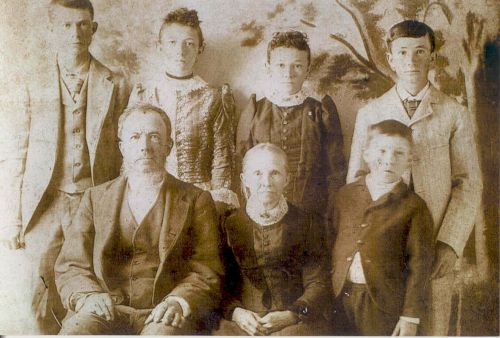
I think all three lineages for Penelope are equally interesting and would be proud to claim any one of them. I just wish I knew which one to claim! Chances are I never will.

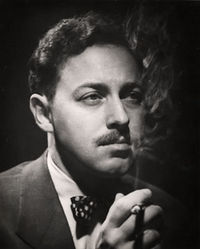 I recently posted about my
I recently posted about my 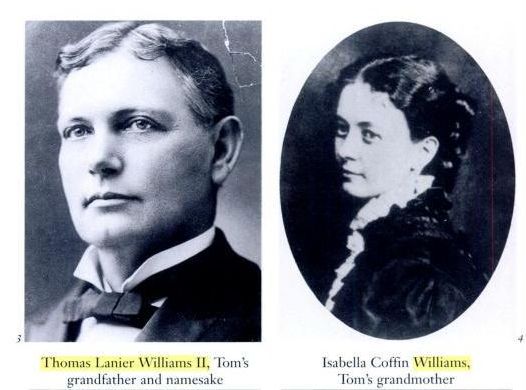
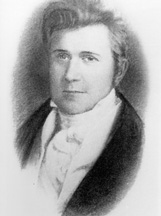 John Williams was born to John Williams (1778-1837) and Melinda White (1789-1838). John Williams, Sr. was known as “Prince John.” He was a veteran of the War of 1812 and
John Williams was born to John Williams (1778-1837) and Melinda White (1789-1838). John Williams, Sr. was known as “Prince John.” He was a veteran of the War of 1812 and 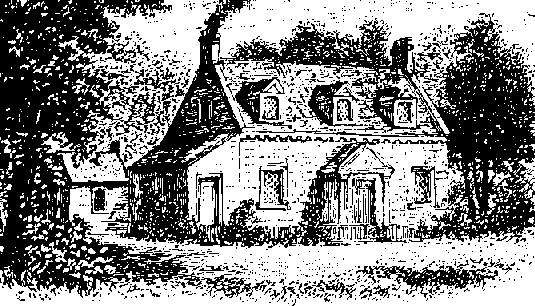
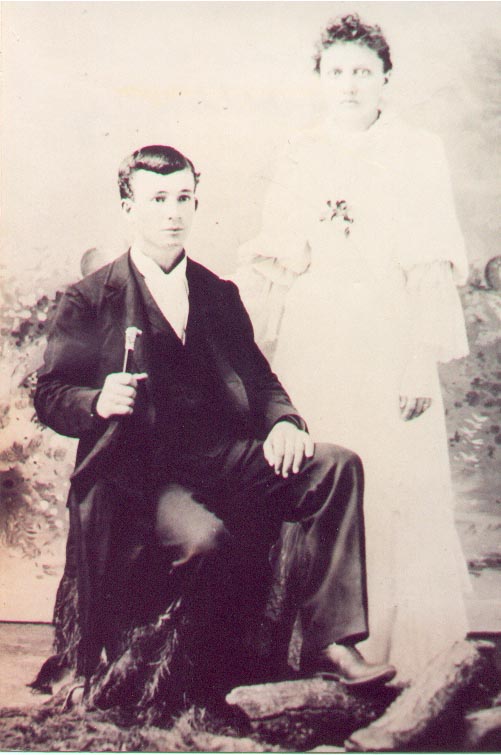
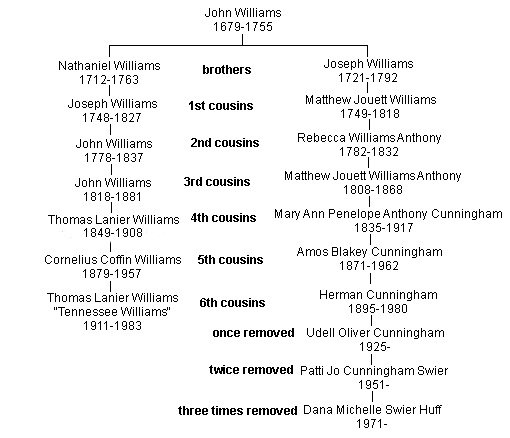
 On February 19, our family lost its matriarch — my great-grandmother, Lucille Thurman. Granny, as she was affectionately known by all of her grandchildren, was 91 years old. Granny had been ill with leukemia for some time preceding her death. She was buried in Marietta, Oklahoma, next to my great-grandfather, Elmer Theodore “Ted” Thurman, who passed away two years ago this past October.
On February 19, our family lost its matriarch — my great-grandmother, Lucille Thurman. Granny, as she was affectionately known by all of her grandchildren, was 91 years old. Granny had been ill with leukemia for some time preceding her death. She was buried in Marietta, Oklahoma, next to my great-grandfather, Elmer Theodore “Ted” Thurman, who passed away two years ago this past October.